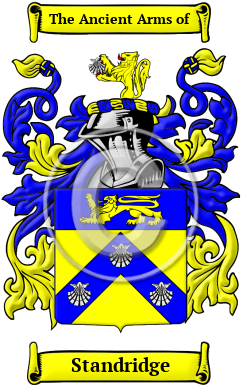| ![Show Contents]() Standridge History, Family Crest & Coats of Arms Standridge History, Family Crest & Coats of Arms
- Origins Available:
England
Etymology of StandridgeWhat does the name Standridge mean? The surname was most likely originally a habitational name, taken on from Stanbridge, a village in the English county of Bedfordshire. Early Origins of the Standridge familyThe surname Standridge was first found in Bedfordshire (Old English: Bedanfordscir), located in Southeast-central England, formerly part of the Anglo-Saxon kingdom of Mercia, where they held a family seat as Lords of the Manor in the parish of Leighton Buzzard. The Saxon influence of English history diminished after the Battle of Hastings in 1066. The language of the courts was French for the next three centuries and the Norman ambience prevailed. But Saxon surnames survived and the family name was first referenced in the year 1276 when Gilbert of Stanbridge was recorded with the estates. Early History of the Standridge familyThis web page shows only a small excerpt of our Standridge research. Another 105 words (8 lines of text) covering the years 1455, 1463, 1474, 1487, 1488, 1505, 1507, 1509 and 1510 are included under the topic Early Standridge History in all our PDF Extended History products and printed products wherever possible. Standridge Spelling VariationsSpelling variations of this family name include: Standbridge, Standbrige, Stanbrugge, Stanbrick, Standbridge and many more. Early Notables of the Standridge familyDistinguished members of the family include John Stanbridge, Stanbury, Stanbery (died 1474), Cornish divine, Bishop of Hereford, was second son of Walter Stanbury of Morwenstow, Cornwall; and John Stanbridge (1463-1510), an English grammarian and headmaster of Magdalen College...
Another 37 words (3 lines of text) are included under the topic Early Standridge Notables in all our PDF Extended History products and printed products wherever possible. Standridge RankingIn the United States, the name Standridge is the 7,509th most popular surname with an estimated 2,487 people with that name. 1 Migration of the Standridge familySome of the first settlers of this family name or some of its variants were: Nathanel Stanbridg, who settled in Virginia in 1623; William Stanbridge, who settled in Virginia in 1635; Rebecca Stanbridge, who arrived in Maryland in 1663.
| Contemporary Notables of the name Standridge (post 1700) | + |
- Gregory Brian "Greg" Standridge (1967-2017), American insurance agent and politician, Member of the Arkansas Senate (2015-2017)
- Rob Standridge, American pharmacy owner and politician, Member of the Oklahoma Senate (2012-)
- David Standridge, American politician, Member of the Alabama House of Representatives
- Alfred Peter Standridge (1891-1963), American Major League Baseball pitcher who played from 1911 to 1915
- Melissa Taylor Standridge (b. 1962), American judge on the Kansas Court of Appeals
- William Gerald "Billy" Standridge (1953-2014), American NASCAR driver who competed in 84 races over 8 years
- Jason Standridge (b. 1978), American former Major League Baseball pitcher who played from 2001 to 2007
 |

